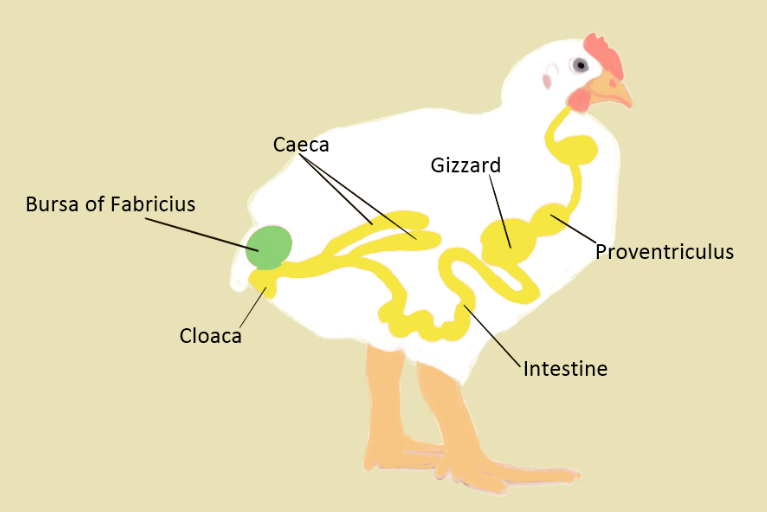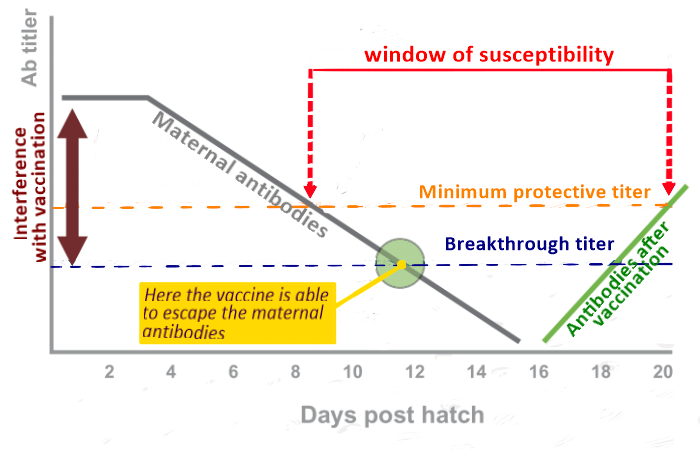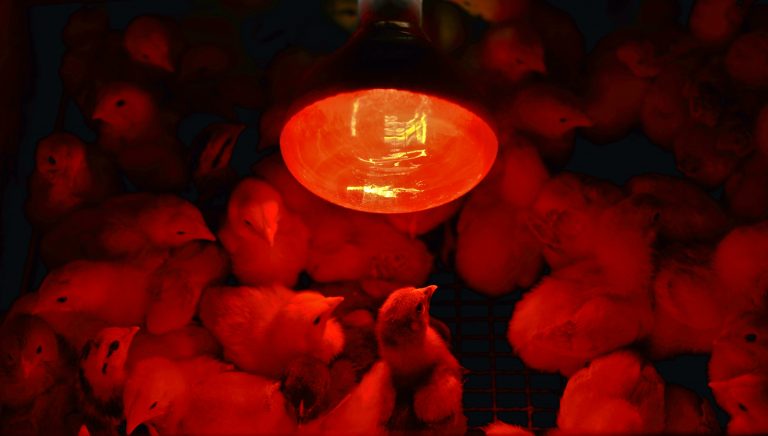Gumboro disease, also known as Infectious Bursal Disease (IBD), is a threat to all poultry enterprises. This is a contagious disease affecting young birds. The virus targets the Bursa of Fabricius, an organ located above the cloaca (Figure 1), in which the maturation of cells of the immune system occurs. This means that one of the main consequences of Gumboro disease is immunosuppression, in other words the inability of birds to properly respond to infectious challenges.
When the infection occurs after the third week, the disease has a clinical form (severe depression, ruffled feathers, vent pecking, and moderate to high mortality) with atrophy of the bursa. When the infection occurs before week three, the disease is mainly sub-clinical, which means that although the bursa is atrophied, there are no clear signs of the disease; instead, secondary infections, poor performance, and mild increases in mortality are observed.
As it happens with many other viruses, there are classic Gumboro virus strains, very virulent strains, and variant strains. Currently, IBD in Zambia is mostly caused by very virulent strains. To understand the implications of infection with very virulent strains, it is necessary to have a look at the immunity of young chicks.

Figure 1: Gumboro disease affects the Bursa of Fabricius, an organ located above the cloaca, in which the maturation of cells of the immune system occurs.
Chick immunity against Gumboro Disease
Chicks hatch with immature immune systems and are protected by the antibodies passed by the hen through the egg yolk (maternal antibodies). When the Gumboro virus enters the chicken, the maternal antibodies neutralise it, avoiding infection.
After hatching, the levels of these maternal antibodies decrease over time (they have a half-life of approximately 3.5 days) (Figure 2). Gumboro viruses (both field and vaccine) can “breakthrough” some level of maternal antibodies (meaning they escape neutralisation), enter the bursa, and multiply (Figure 2, yellow label).

Figure 2: Dynamics of chick’s antibodies against Gumboro Disease virus.
This presents us with two challenges when trying to protect the birds against the disease:
- The level of maternal antibodies varies between chicks, therefore the period of protection by maternal antibodies can differ significantly in the same batch of birds.
- The antibody level at which Gumboro viruses can breakthrough varies significantly. Very virulent field strains (as the ones found in Zambia) can have a breakthrough level up to 20 times higher than mild vaccines, being able to reach the bursa earlier than most vaccines.
How to protect the birds against very virulent strains?
Firstly, it is important to have a tight biosecurity program.
Secondly, it is key to ensure that parent flocks have good immunity against Gumboro. This will result in chicks with more maternal antibodies against the disease.
Thirdly, vaccines that can break early through maternal antibodies are able to reach the bursa before very virulent field viruses do, excluding them and protecting the bursa from infection.
How do live Gumboro vaccines work?
Live vaccines against Gumboro work in two ways. Firstly, by reaching the bursa before the field virus, vaccinal viruses colonise the bursa first, avoiding field infection. Secondly, as the maternal antibodies disappear and the immune system becomes functional, the bird will produce antibodies that will protect the birds against the Gumboro field strains.
The time between the drop of maternal antibodies below protecting levels and the beginning of the immune response to the vaccine determines a period in which the birds are more susceptible to suffer infection (Figure 2). Based on the level of maternal antibodies in the first days of life, your veterinarian will recommend the best dates for your flocks to be vaccinated and best manage that susceptibility window.
MB, the vaccine strain that best protects against current Zambian strains
The MB strain was obtained after the attenuation of the very virulent KS strain isolated in Israel in 1989. Because of its unique genetic makeup, it induces immunity against the very virulent Gumboro strains circulating in Zambia. Unlike other vaccine strains, due to its ability to break through high levels of maternal antibodies, MB strain can reach the bursa before the very virulent field strains, protecting birds from as early as seven days (if maternal antibodies are very low).
After the replication of MB strain in the bursa, there is a reduction in the size of this organ. However, exhaustive experimental work determined that the immunity of birds vaccinated with MB was not compromised in any way; these birds were able to develop normal protection when vaccinated against other diseases.
After MB replicates in the bursa, it is shed to the environment, colonising the farm. This constitutes an additional benefit since infectious field strains are eventually displaced by the MB vaccinal strain.

MB-1, cutting edge solution to control Gumboro Disease
Zambian farmers are already acquainted with the benefits of using MB vaccines in their traditional formats, like the vials (Gumboro MB), the easier-tostore, eco-friendly tablet form (TAbic MB), and the inactivated vaccines for breeders (GumbinVP2). From small producers to large corporate enterprises, MB has been key in the control of persistent Gumboro problems in Zambia.
Phibro has recently added a fourth solution to the MB live vaccine family: MB-1. Thanks to this development, MB strain can be applied at the hatcheries both in-ovo (at 18.5 days of incubation) and by injection at the hatchery. The virus, when injected, gets covered by the maternal antibodies (formation of immune complexes), and released as the maternal antibodies decay. Therefore, the vaccine virus will reach the bursa at the best time for each chick, resulting in the individual adjustment of immunity development. We will discuss MB-1 in more detail on our next article.
Your veterinarian will be able to advise on the most suitable way to use MB strain at your farm.
For more information on Phibro MB-1, visit www.pahc.com/mb1/home/









